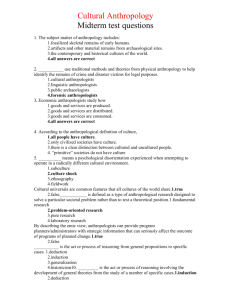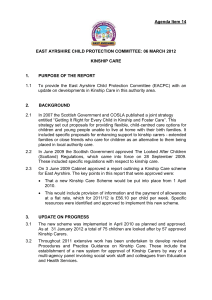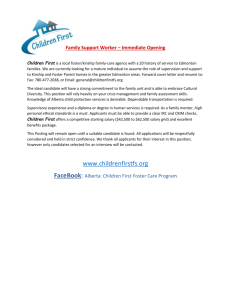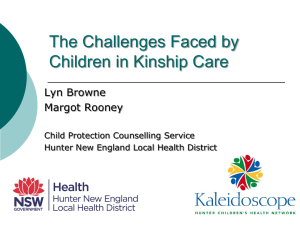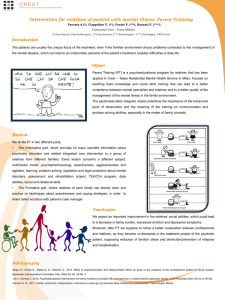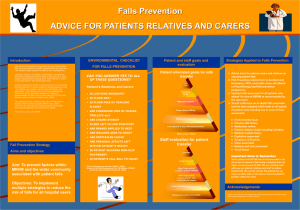A Typology of Kinship Care Networks
advertisement
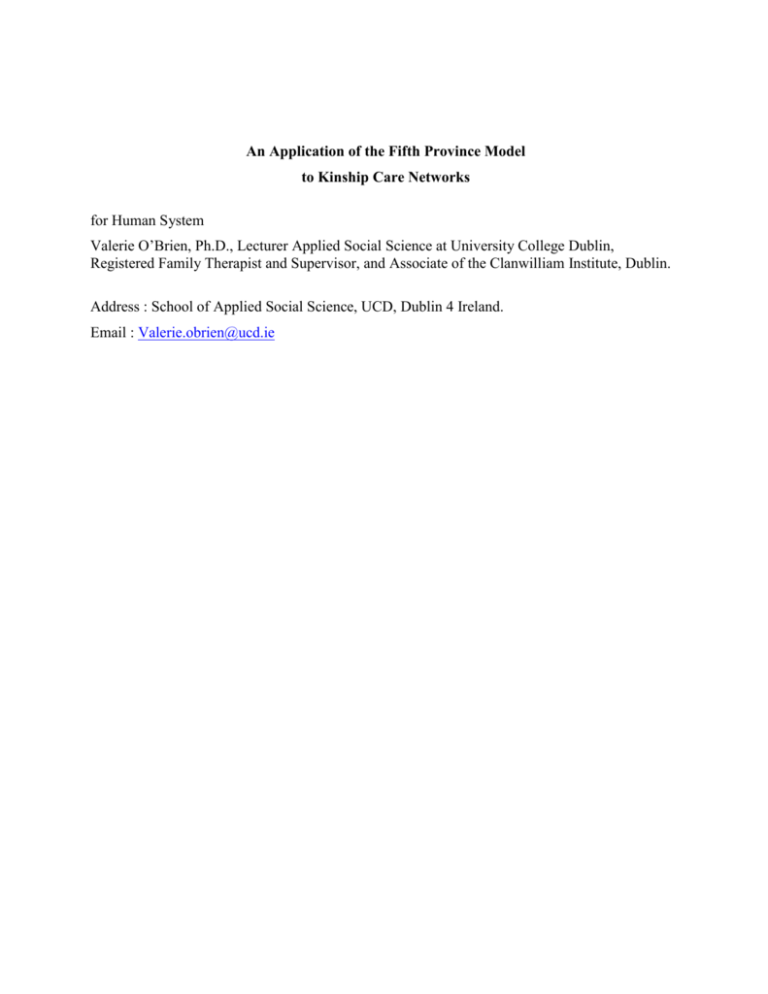
An Application of the Fifth Province Model to Kinship Care Networks for Human System Valerie O’Brien, Ph.D., Lecturer Applied Social Science at University College Dublin, Registered Family Therapist and Supervisor, and Associate of the Clanwilliam Institute, Dublin. Address : School of Applied Social Science, UCD, Dublin 4 Ireland. Email : Valerie.obrien@ucd.ie An Application of the Fifth Province Model to Kinship Care Networks Abstract i Kinship care represents a significant option for increasing numbers of children in need of state care (Nixon 2007; Colton et al 2008). There are many positive outcomes from such placements (Hunt et al 2008, O’Brien 2012a). While there have been some interesting systemic developments (Crumbley & Little 1997; Portengen & DerNeut 1999, Ziminski 2007a, 2007b), a level of confusion remain as to the nature of the relationships involved in kinship networks. Furthermore, a service delivery model, characterised by the professionals holding much of the power, expertise and regulatory responsibility has dominated (O’Brien 2012b). This has led to disquiet among many practitioners, family members and managers. This paper contends that an understanding of the different network is a critical starting point to aiding development. Building on earlier work (O’Brien 1997, 1999), the ‘fifth province model’ from the systemic field, is shown to provide a conceptual and intervention framework to aid this development. The model provides a means to understand various networks that can evolve. This analysis is achieved through an application of ‘diamonds’, which are a hallmark of the fifth province. Discussion of the author’s journey towards understanding of the fifth province model is central to this appraisal of its application in kinship care. Introduction The Fifth Province model is introduced and used in this paper to: (i) provides a conceptual framework for examining state / family relationships assist in an understanding of various networks of relationships that can occur among the children, birth parents, relatives and the agency workers involved (ii) show how the analysis can offer direction to professionals and managers in terms of the direction in which kinship placements and networks can evolve, to indicate the level of support, supervision and therapeutic interventions that may be required, and to show how a space can be created in which the voice of all the participants can be heard. This is achieved through presenting an overview of the Fifth Province model. It is followed by presenting a typology of kinship networks first identified through research (O’Brien 1997; 1999) and discusses how the original networks have been further developed through a combination of ongoing training provision, case consultation, and model development (O’Brien 2004, 2009a, 2012b)ii. The networks are broadly described, using the two structural formats of the model ‘symmetrical competitive’ and ‘complementary cooperative’ configuration of relations (Byrne et al, 2002). The two formats are represented spatially through diamond structure, as depicted on Figures 1 and 2 below. Certain themes and features of the different networks of relationships, worked with and observed over the years, are depicted on the diamonds. The paper concludes by discussing how the network analysis can be incorporated into practice while calling attention to issues policy-makers need to consider when contemplating kinship care developments. The Fifth Province Model The fifth province model was developed from clinical research in the area of sexual abuse disclosure (McCarthy 1991; McCarthy & Byrne 1988). The fifth province approach is a postMilan clinical application that utilises a cybernetic frame to conceptualise relational and thematic configurations in a context in which the therapist/researcher is a participant. The model challenged and extended the Milan use of neutrality by developing a therapeutic approach for systems involving families and state agencies, where issues of social control were to the fore. It has been elaborated as an approach for working with complex systems with particular reference to poverty, gender inequality and marginalisation (Hyden & McCarthy 1994; Byrne & McCarthy 1995, 1999, 2007; Byrne 1995, McCarthy 2010a); intercultural issues (McCarthy & Byrne 2008); power (McCarthy 2010b) and dialogical co-creations (McCarthy 2010a). The fifth province model has gained considerable recognition in the systemic field (Hoffman, 1988; Hannah & McAdam, 1991; Tomm, 1992; Stroier, 1993;; Anderson, 1997; O’Brien 1999, 2009a; Partridge, 2007; McGolderick & Hardy 2008; Keenan 2012). The creators attribute the principal influences on their developing model to Milan systemic therapy, Bateson’s application of cybernetics thinking to understanding movement in systems, Maturana’s focus on emotions and Irish mythology. The name ‘fifth province’ is drawn from Irish mythology and the work of Hederman and Kearney (Kearney et al 1989; McCarthy 2005). According to McCarthy 2010b, the myth is that ‘the fifth province was situated right in the centre of the country where the four provinces were thought to have met. It was said that it was a pagan Druidic site where kings and leaders from the other provinces came to settle their conflicts and reconcile their disputes through conversation and talks. Arms were left aside as people came together to speak and receive counsel. It was a place of dialogue where all opposing and contrasting views could be held together, heard and voiced in a non-violent way’ (p.2). Thus, as a metaphor, the fifth province is an ethical disposition that speaks to the possibility of openness (McCarthy 2010a). The principal features of the Fifth Province approach used in this article are the two structural formats of symmetric and complementary configurations of relations, depicted on diamonds. The Diamonds Following Bateson’s description of complementary and symmetrical interaction in systems, and with symbols influenced by the work of Minuchin (1974), two diamond structures were developed within which relationships, themes and discourses could be mapped (McCarthy 1991). These are symmetrical competitive systems and complementary co-operative systems, as illustrated in Figures 1 and 2. A symmetrical competitive system is a description of a social field which has an ambivalent structure of opposition and contradiction. This is evident in the divergence of discourses and the mutually opposed position of participants. The diamond shape used to denote a symmetrical competitive system is in the form of A:B::C:D (Fig. 1). Complementary co-operative systems refer to systems which have an ambivalent structure of contrast and exclusion. According to Byrne, in the complementary system ‘a combinatory rule operates that establishes a tripartite field of affiliation with the fourth pole excluded’ (1995: 256), as illustrated in Figure 2. The issue of the exclusion based on difference or inequality has implications for intervention particularly if, by the intervention, the voice that is already silenced continues to be silenced or marginalised. Likewise if the intervener aligns with the silenced voice to the exclusion of the other participants, the intervention may be disqualified, leading to either a removal of the intervener from the system, or the system may change to a symmetrical competitive system. Figure 1 Symmetrical Competitive System Intersecting field Competition (Opposition) A Affiliation Disjunction/Disconnection C D B Combinatory Rule A:B : : C:D Figure 2 Complementary Co-Operative System Intersecting field Co-operation Affiliation A > Disjunction/ Exclusion C D B Combinatory Rule AB (C) /D Adapted: Byrne (1995: 257) In addition to the diamond structures used to depict a symmetrical competitive system and a complementary co-operative system, a ‘rough diamond’ is also used to illustrate the relationship of themes and relationships to one another and is useful in the mapping of unfolding processes. It is illustrated in Figure. 3. Figure 3 Rough Diamond A C D B The creators incorporated the imagined fifth province into the four-way diamond figure to position the team and guide the inquiry. Placing the team at the central confluence where continuum lines form the central point of the diamond figure was thought by the creators to bring forth for them a fifth province within a therapeutic setting. The team were both implicitly and explicitly part of all possible triangular configurations (McCarthy 1991: 126). The themes as presented on the diamond are ‘intended to facilitate the exploration of standpoints as opposed to the premature capture and resolution of the opposing elements’ (Byrne and McCarthy 1995: 49). McCarthy’s (2010c) work expands on the format where she says that the diamonds are playthings and ‘not carved in stone’. They are ‘socially situated constructions, which are produced in the inter-weave of conversations between participants...... they serve mainly as temporary scaffoldings to support work in complex situations’ (p 1). A Typology of Kinship Care Networks The four types of kinship networks are presented in Figure 4. While first researched in 1997, further developments (O’Brien 2009, 2013) have led to a level of adaptation. Two broad categories, characterised by ‘complementary co-operative’ system (three networks) and ‘symmetrical competitive’ system (one network) are discussed. Each network is depicted on a fifth province diamond/map. Figure 4 Categories of Kinship Networks. Complementary Co-operative System Distressed Symmetrical Competitive System Shared Care Quasi Adoption (C) Oscillating Shared Care Networks: Exclusion of the Agency The relationships in the network called “shared care: exclusion of the agency” are characterised by a significant and stable co-operative relationship between birth parents and relatives as illustrated in Figure 5. The origins of shared care networks are traced to the initial decision- making stage, when a crisis occurs which results in the agency and the family coming together. It is described as a shared care/ joint care arrangement, as there are high levels of agreement between relatives and birth parents. Based on an assessment of risk, the agency is satisfied to accept a peripheral position, when the formalisation of the placement is completed. However the dominant co-operation of birth parents and relatives excludes the agency from any significant role. From the agency’s point of view, the ideal arrangement may be in place, but masks a significant exclusion. The network of shared care is the closest to the optimal arrangements of respect, love, protection and openness aspired to by participants in kinship care. Figure 5 Shared Care : Exclusion of Agency Parents Relationship not threatened Distant but cordial Child(ren) Agency Respectful & maintain distance One of the family Relatives Quasi-Adoption Network: Exclusion of Parents The network called “Quasi-Adoption” is also characterised by both co-operative and excluded relationships and is presented in Figure 6. In this network, a co-operative network of relationships evolves based on mutual agreement of relatives and agency for the care plan. The difference in this network is that the parents are absent. The exclusion or absence of the parents results in the network having many similar characteristics to a “quasi-adoption” placement. The relationship between the child and relatives is characterised by closeness. The agency’s position is attributed to an assessment of risk, which indicates that the protection needs of the child are adequately met by the relatives. The absence of parents for a prolonged period results in the agency generally respecting the quasi-adoptive nature of the placement. Limited contact between professionals and relatives does not pose a threat to the stability of the plan, as a dominant co-operation is in place in ‘the best interests of the child’. Unlike the shared care networks, quasi-adoption is characterised by the distance and exclusion of the parent(s) from the other participants. The principal relationship is between the relatives and the agency, where responsibility for care of the child is mutually agreed. Figure 6 Quasi Adoption : Exclusion of Parents Agency One of our own Absent Parents Child(ren) Absent Child Protection Relatives .. Shared Care and Quasi-Adoption Networks - Some Conclusionsiii The shared care and quasi-adoption networks may describe a minority of kinship placements in agencies. Many of the features of the quasi-adoption and shared care networks are similar. The history of informal care, voluntary care status, a positive assessment by the agency of the relatives’ ability to protect the child and make their own arrangements as fully as possible and general satisfaction by the relatives at the level of agency service, support and position are common to both networks. The difference which accounts for the separate, though connected, categorisation relates principally to the closure in the relationship between the parents and other participants in the quasi adoption network. In the parents’ absence, the relatives become the principal parental figures for the child. This fundamentally alters the way in which the relationship is experienced and viewed by the different participants. When the assessment procedure is completed, the agency respects the “special family relationship” and is more prepared to accept a distant but respectful relationship with the relatives and child. These networks tend to evolve as a response to a particular set of circumstances, such as the agency being satisfied that the child’s protection needs were met, low priority of these cases given the demands of other more pressing cases, and the lack of conflictual familial relationships which means that the child is not involved in torn loyalties. These factors account for the cases being seen as ones that require minimum attention in the overall context of the agency’s work. The advantage for the children in both networks, is that they are claimed by the family from the outset, thus usually preventing a placement outside their network. Children have membership in their kin, and they appreciate the security this offers. Relatives are supported by the agency through payment of allowances and generally know they can contact agency workers if required, though many have limited experience of doing this in their day to day lives. This can be part of the under-lying ambivalence that can exist in the relationship between the families and the statutory agency. This may be centred on intrusion / privacy and the extent to which families should be able to control their own destinies (O’Brien 2000, 2001, 2009). Financial needs propel relatives to stay as part of the kinship care system, and many could not afford to look after the child from their own resources. The trend in recent years to divert many of these placements from the formal system - either at the point of first contact or once the placements are stable - has been a feature of practice in a number of countries. This has been achieved through the use of instruments such as residence orders in the UK (Hunt et al 2008), special guardianship (Hegar 2005) specified kin payments such as in Australia (Kiraly & Humphries 2011) or simply through providing a package of support services (O’Brien 2012d). Network meeting(s) which include professionals and family members, and based on the principles of ‘family group conference’ have been used (Worrall 2007). This intervention has greater potential for working with kinship care than has been realised (O’Brien 2012c). They could be used to monitor progress of the placement, assess needs and service requirements, or at other key decision making junctures such as clarifying the need for placement or deciding if the placement should be diverted out of the formal system. The practice of diversion however, raises key policy issues, especially given the evidence that many families, in what is now termed informal kinship care (limited state involvement and largely negotiated/ sustained privately within extended families) are at much higher risk of poverty and lack access to much needed services (Nandy & Selwyn 2012). This is a matter of concern, especially as an established feature of formal kinship care is that relatives are by and large older, poorer and generally receive much less supervision and support compared to non kin foster carers (Doolan et al 2004; Hegar & Scannapiece 2005; Farmer & Moyers 2008; O’Brien 2012). Faced with this situation, the drive to divert without ensuring adequate provision may perpetuate further inequality and pressure on families. This is an issue which needs very careful monitoring. Distressed Network : Exclusion of Parents The ‘Distressed’ network is third type of network organised by the complementary cooperative structure and is illustrated in Figure 7. In this network, there is an alliance between the agency and relatives regarding the care and protection of the child, there is high level of disagreement between the parents and other participants and, as a result, the parents are distanced and marginalised. The placement has usually been court-mandated, though there may have been a period where the arrangements had been more cooperative and were sustained on a more informal basis. In contrast to quasi-adoption networks, the children in these networks have access to the marginalised narrative as a component of their identity. Figure 7 Distressed Network Agency Care and Protection Complaints Child(ren) Birth Parents Complaints Care and Protection Relatives Evolution of Distressed Networks. iv It is important to note that, in tracing the development of distressed networks through the different junctures in the care process, they usually do not enter the care system bearing the hallmarks of such “distress”. Placement with relatives would not be sanctioned by the agency at the decision-making stage if levels of conflict were such, as it would be seen generally as placing the child in a too high risk situation. Instead, the evolution of the distressed networks is traced generally to unfolding events over the duration of the placement. The conflict between the parents and the other participants is usually not ascribed to a single issue. Rather the conflicts may be traced to differing interpretations of initial care plans, shattering of hopes that problems can be resolved and children returned, and differing expectations and views of family relationships and agency. The conflicts are played out within the different processes, connected with assessment, support, and access, and centre on the twin questions of “who owns this child?” and “who is in control” (O’Brien 2012b). A central feature underlying the distressed networks is the extent of the struggle for the relatives to maintain the placements. The struggle can centre on the sacrifices of rearing additional children, the financial burdens, lost opportunities, loss of support networks and effects on their own children. Interventions to mange and de escalate conflicts. A range of interventions aimed at managing the clinical issues are as follows: Network meetings could be a regular feature of the service and could provide space where the conflicts can be named /resolved. An advocate for the parents at such meetings is needed to avoid further escalation of the conflict(s). A multi-disciplinary team structure is critical, especially given the likelihood that mental health and addiction issues may be central to parents’ difficulties. Specific training for relatives aimed at enhancing understanding of the problems of parents may be beneficial to diffuse the difficulties as the network develops. Specific therapeutic work between relatives and parents aimed at holding levels of cooperation usually present at the early stage of placement is important. While dyadic and triad intervention will be required, individual therapeutic and support services will also be required for many of the participants. Oscillating Network: Family Loyalty and Child Protection The fourth network is entitled ‘oscillating’. It is the only network organised by the Symmetrical Competitive System and is illustrated in Figures 8 (i) and 8 (ii). In this network, the relationship between the parents and relatives is characterised by intense ambivalence. This arises from the combined/ dual roles of being a family member and kinship foster parent. This is the central relationship in the network, which in turn shapes other relationships. The family’s desire to protect themselves from outside interference (agency) is central to the ambivalence. The agency remains apprehensive about the extent to which the children are protected within the family. The voluntary nature of the care arrangement results in the agency occupying a more peripheral position, despite their level of apprehension about some of the developments. The oscillation in the relatives and parents relationship in turn shapes the agency’s relationship with both, with each typically on occasion calling on the agency to support their position. Fig 8 (1) Oscillating : Family Loyalty & Child Protection Parents Family Loyalty Threat of court mandate Risk Risk Child(ren) Relatives Risk Risk Threat of court mandate Child Protection Agency In the scenario outlined in Figure 8 (i), the relatives and parents are affiliated, and the agency is increasingly anxious about the protection of the children. The familial risk emerges from the intense ambivalence, which fluctuates between the parents and the relatives and is here masked by an alliance, which is unstable. The risk to both parent and relatives emerges from this potential instability and may be punctuated by the agency’s application for a court order. Here the question of risk is paramount for the agency. Conflict arises in the parents’ relationship with the relatives, provoked by excessive demands of the latter, or increased questioning of the relatives capacity to work with the agency. This brings forth a rupture of affiliation between the parent and relatives, and raises the parent’s wish to take the children home despite the lack of adequate parental resources, as presented in Figure 8 (ii). Fig 8 (2) : Oscillating Network Breakdown of Loyalty – Kinship Care vs Reunification Agency Kinship Care? Reunification? Threat of court mandate Protect Child Child(ren) Relatives Protect Family Complaints Reunification Parents In an escalating crisis, the relatives switch their alliance from the parents to the agency to secure their role as carers, and significant complaints about the parents emerge. The parents situate themselves in a competitive relationship with the agency with the aim of reunification, and the children’s desire to protect and support the parents emerges more strongly. As the agency attempts to secure the role for relative care through a court mandate, the original alliance of family loyalty returns (Figure 8 (i)). In this network, the difficulties can be played out at every stage. The junctures of decisionmaking, assessment, and the actions involved in access, support, planning, and reunification all provide flash points in which the difficulties in the network of relationships can emerge. Each of these events provides a context in which the underlying difficulties in the relationship are played out, which also contribute in part to the continuation of difficulties. participants. Each event positions the Protection of the children. Being caught in the cross-fire of oscillating family and family/ agency relationships is undoubtedly one of the main difficulties for children arising in oscillating networks. The degree to which children can cope with shifting loyalties is further complicated if the children are mistrustful and fearful of the agency (2002b). They may regard the agency as having the power to remove them on a more permanent basis from their parents. This may be accentuated if the agency is unclear about the extent to which the children’s needs for care and protection should take priority over the family’s need for privacy, loyalty and integrity. The dilemma facing the agency involves balancing the benefits of the relative placement for the children against the possible harm it may induce. The agency has to be aware that, when dealing with oscillating networks, they may be vulnerable to accusations of failing to ensure that legislative and professional responsibilities are adequately met, as they allow the children to stay in volatile situations where there is some doubt about the level of protection offered. However, it is likely that ambivalent networks evolve when the reason for care is associated with chronic difficulties of the parents, rather than from acts of deliberate abuse or neglect. The agency maintains sympathy for the difficult life circumstances of the parents and is thus, reluctant to secure a court order, which would occur if evidence of more abusive behaviour towards the children were present. The ambivalence among agencies in managing neglect cases is a well recognised phenomenon. A court order or at least a court application may provide a clearer basis for care, thus reducing the oscillation in the relationship between birth parents and relatives. However, court orders are not, however, proposed as a simple solution to the difficulties in oscillating /ambivalent networks, as the more negative consequences of care orders, highlighted particularly in the distressed networks, have to be considered. A proactive stance is needed at the commencement / earlier stage of formal placement; again network type meetings to make explicit the care plan assess needs and service provision. As the placement develops, different needs may emerge and services can be organised accordingly. It is important to avoid separate the two worker model which is usually part of foster care service, ie specific worker for children/ family and separate worker for the foster carer. Instead, two / three workers should work conjointly with the network focusing on various tasks. Minimising Conflict : Achieving Greater Consensus in Kinship Care. It is important to consider both the shared and different characteristics across the different networks to enable effective interventions to occur and good outcomes to be realised. The shared care (Figure 4) and quasi adoption networks (Figure 5) are described as ones in which relationships between the significant participants contain a higher level of consensus. These placements are more likely to be characterised by higher levels of partnership, collaboration, multi-laterality, mutuality and co-ordination, compared to the distressed and oscillating networks, even though there are still parties that hold more marginal positions. General agreement of the care plan ‘in the best interest of the child’ by the birth parents and the other participants is required for a more consensus network of relationships to evolve. While disagreements may arise on occasion, nonetheless the level of difference of opinion should not be sufficient to threaten the stability of the overall plan. However, the stability will be challenged if fundamental change is enacted. For example, the return of the birth parents without the expressed permission of the relatives and less so the agency in the ‘quasi adoption network’ could de stabilise the network. Managing Conflict : Minimising the Escalation. There are much higher level of conflicts in the distressed and oscillating networks compared to shared care and quasi-adoption networks, but there the similarity ends. The ‘distressed’ network is generally court-mandated, reunification does not form part of the current care plan, access is usually problematic, relatives are struggling to hold the care together, sometimes against a background of great personal sacrifice and the parents are marginalised and excluded. Pain, disappointment and despair co-exist in families, with a hope that the birth parents will be less resentful of the care plan at some future date. The distressed network bears all the hall marks of network that may find it difficult to reverse the damage to the relationships and thus the focus must be on how to ensure that such an escalation is avoided if possible. On the other hand, the oscillating network is characterised by a high level of uncertainty regarding the care plan and thus the ambivalences that are present are amplified and disqualified at a fast pace. The uncertainty can continue due to the interplay of multiple factors : legislative, social, emotional and financial and in this context, attention is needed to ensure that a robust assessment of what is occurring takes place (O’Brien 2012). Conflict is high, huge agency resources are expended and without a clear understanding of how ambivalence is shaping the relationship field, the professionals become overwhelmed. It cannot remain oscillating on a long term basis but a lot of damage can be done, if an awareness of the dynamics and clinical & judicial options available are not fully considered. Conclusion and Moving Forward This paper builds on previous research that indicates a different way of working with kinship care is urgently required An understanding of different networks of kinship care, their characteristics and how they may evolve is a prerequisite to this development. Through the Fifth Provence methodology, the application to kinship care has shown how it: contributes a method of analysis where, through use of diamond-shaped structural maps, emerging themes can be mapped through a representation of alignments and non-alignments. This scaffolding enhances an understanding of the place of contradictions and oppositions and sees ambivalence as more ‘normative’ in the various networks. Through understanding the themes, dynamics and the central place of ambivalence within a complex network of relationships, it has been seen how voices can be easily silenced. This finding fits with the call among researchers and practitioners (Munro 2011) that a more ‘relationship-based’ intervention model, based on the principles of partnership, respect and collaboration and where the child is protected, is needed urgently. The Fifth Province model can facilitate such inclusive collaborative relational conversations among the participants in the kinship network. The negotiation of openings is a central requirement for participation in a multi-party conflictual and ambivalent field. In this context the diamonds enhance the therapists positioning and thus reflexivity and systemic and circular questions aids opening up and resolution. Clarity in respect of commissioning objective/s and the interventions that may be required and by who is an essential first step. The model can work alongside family decisionmaking models at different stages and for different purposes across the networks. To conclude, while a range of tools and analysis are offered, it is important to hold these tools lightly and to keep the focus on reflective, respectful, partnership and relational practice while staying very tuned into the ethical, cultural, and political and policy considerations that are at the heart of kinship care. REFERENCES Anderson, H. (1997). Conversation, Language and Possibilities: A Post-Modern Approach to Therapy. Basic Books, New York. Bateson, G. (1980) Mind and Nature. Glasgow, Fontana. Byrne, N. & McCarthy, I. (1999) Feminism, Power and Discourse in Systemic Therapy: Fragments from the Fifth Province. In Parker,I. (Ed) Deconstructing Psychotherapy, London, Sage. Byrne, N.& McCarthy, I. (1995). Diamond absolutes: A daughter’s response to her mother’s abortion. Journal of Systemic Consultation and Management, 6, 225-277. Byrne, N. Kearney, P. & McCarthy, I. (2002) Initial steps in the fifth province. Feedback. 9, 21 22. Byrne, N. & McCarthy, I. (2007). The dialectical structure of hope and despair: A fifth province approach. In C. Flaskas, et al (ed.), Hope and Despair in Family Therapy: Reflections on Adversity, Forgiveness and Reconciliation. Routledge, London. Colton, M. et al (2008). The recruitment and retention of family foster-carers: An international and cross-cultural analysis, British Journal of Social Work, 38, 865-885. Crumbley, J. & Little, R. (1997). Relatives Raising Children: An Overview of Kinship Care. Washington: Child Welfare League of America. Conway, E. & O’Brien, V. (2004). A Standardised Framework for Domestic Adoption Preparation, Assessment and Decision Making Procedures. Dublin: Irish Adoption Board. Doolan, M. et al (2004). Growing Up in the Care of Relatives or Friends. Family Rights Group, London. Farmer, E. & Moyers, S. (2008). Kinship Care: Fostering Effective Family and Friends Placements. Jessica Kingsley, London. Flaskas, C. et al (2007). Hope and Despair in Narrative and Family Therapy: Adversity, Forgiveness and Reconciliation. Routledge, London. Gardner , F. (2012). The cat, the rain and meaningful conversation: Reflexivity and practice. In S. L. Witkin, Social construction and practice, Columbia University Press, New York. Greeff, R. (1999). Fostering Kinship Care. Arena, Ashgate. Hyden, M. & McCarthy, I. (1994) Women battering and father –daughter incest disclosure: Discourses of denial and acknowledgment. Discourse and Society, 5, 543 -565. Hannah, C. & McAdam, E. (1991). Violence part 1: Reflections on our work with violence, Journal of Systemic Consultation and Management, 2, 201-206. Hoffman, L. (1988). A constructivist position for family therapy, Irish Journal of Psychology, 9, 110-129. Hegar, R., & Scannapieco, M. (2005). Kinship care. In G. Mallon, P. McCartt Hess, (ed.), Child welfare.for the 21st century, Columbia University Press, New York. Hunt, J. et al (2008). Keeping Them in the Family: Outcomes for Children Placed in Kinship Care Through Care Proceedings, BAAF, London. Kearney, P; Byrne, N. & McCarthy, I. (1988) Just metaphors: Marginal illuminations in a colonial retreat. Family Therapy Case Studies, 4, 17-31. Keenan, M. (2012). Opening a space for hope in a landscape of despair: Trauma and violence work with men who have sexually abused minors. In Witkin, S.L. (Ed) Social Construction and Practice, Columbia University Press, New York. Kiraly, M., & Humphreys, C. (2011b). Look at it From the Parent’s Point of View As Well: Messages about Good Practice from Parents of Children in Kinship Care. Melbourne: Office of the Child Safety Commissioner and University of Melbourne. McGolderick, M. & Hardy, K. (2008) Re-Visioning Family Therapy: Race Culture and Gender in Clinical Practice, (Ed) Guildford, New York. McCarthy, I.C. & Byrne, N.O’R. (1988). Mistaken love: Conversations on the problem of incest in an Irish context, Family Process, 27, 181-199. McCarthy I.C. & Byrne N.O’R. (1995). A spell in the fifth province: It's between meself, herself, yerself and your two imaginary friends, In S. Friedman (ed.), The Reflecting Process in Action, Guilford, New York. McCarthy, I, & Bryne, N. (2008). A fifth province approach to intra-cultural issues in an Irish context : Marginal illuminations’ in Revisioning Family Therapy: Race, Class, Culture and gender in McGoldrick, M. & Hardy, K. (ed.) New York: Guilford Press. McCarthy - Colgon, F.I. (1991). The Fifth Province Model: Father Daughter Incest and System Consultation. Ph.D. Dissertation, University College Dublin. McCarthy, I. (2005) From Milan to the fifth province: The legacy of Gianfranco Cecchin. Journal of Human Systems, 17, 257-263. McCarthy, I. (2010a). The fifth province: Imagining a space of dialogical co-creations!, Context, 6-11. McCarthy, I. (2010b). A traumatic intrusion with transgressive possibilities: Power as a relational and discursive phenomenon, Context, 21-24. McCarthy, I. (2010c). Fifth Province Diamonds: Contrasts in Co-Ordinated Play. Unpublished. Minuchin, S (1974). Families and Family Therapy. Cambridge. M.A: Harvard University Press. Nixon, P. (2007). Relatively speaking: Developments in Research and Practice in Kinship Care. Research in Practice, Dartington. Nandy. S & Selwyn. J. (2012). Kinship care and poverty: Using census data to examine the extent and nature of kinship care in the UK. BJSW, http://bjsw.oxfordjournals.org/content/early/2012/05/08/bjsw.bcs057.abstract (Accessed December 3rd 2013). O’Brien, V. (1997). Fostering the Family: A New Systemic Approach to Evolving Networks of Relative Care. Ph.D. Thesis, Submitted to National University of Ireland. O’Brien, V & Richardson, V. (1999) Towards a standardised framework for inter-country adoption, Dublin: Department of Health and Children. O’Brien, V. (1999). Evolving networks of relative care: Some findings from an Irish study. In Kinship Care. Greeff, R. (ed). Ashgate, Arena 113 -134 O'Brien, V. (2000). Relative care: A different type of foster care - implications for practice. In G. Kelly, & R. Gilligan (ed.), Issues in foster care: Policy, practice and research, Jessica Kingsley, London, 193-213. O'Brien, V. (2001). Contributions from an Irish study: Understanding and managing relative care. In B. Broad, Kinship Care: The placement choice for children and young people. Lyme Regis: Russell House. 59-72 *O'Brien, V. (2002a). Relative care: Issues for social care workers, in Irish Journal of Applied Social Studies, 3, 51-68. O’Brien, V. (2002b). Children and relative care. In Quin, S et al Children in Irish Society. Vol 2, Oak Tree: Cork. 69 - 98. O’Brien, V. (2004) Assessment of the relative home. Care planning, assessment and decision making: Towards a Practice Model. Mid Western Health Board, Limerick. O’Brien, V. (2009a, July 13-17) Understanding the complexity of foster care and the implications for relationships within the family. In International Foster Care Conference: Linking Global Foster Care: University College Dublin O’Brien, V. (2012a) The benefits and challenges of kinship care, Child Care in Practice. 18 (2): 127-146. O'Brien, V. (2012b). Responding to the call: An innovative conceptual model for kinship care assessment. Child and Family Social Work, Article first published online : 25 OCT 2012, DOI: 10.1111/cfs.12025 O'Brien, V. (2012c). The Place of Family Group Conferencing in Child Welfare in the Republic of Ireland. In: The quiet revolution. Aggrandising people power by Family Group Conferences . Amsterdam: SWP. O'Brien, V (2012d). 'Kinship care: enhanced support needed' In: Voices of the Forgotten: 30 Years of the International Foster Care Organization . USA: IFCO Vanity. O'Brien, V. (2013). Kinship Care: Stability, Disruption and the Place of Support Services. Irish Foster Care, 15-17. Partridge, K (2007) The positioning compass: A tool to facilitate reflexive positioning, Human Systems : The Journal of Systemic Consultation & Management, 18, 96 -111. Portgengen, R & Der Neut, B. (1999). Assessing family strengths: a family systems approach. In R, Greeff (ed.) Fostering kinship: an international perspective on kinship foster care. Aldershot: Ashgate. 35-48. Stroier, V. (1993). Benchmarking the systemic way: how to learn from the best ideas around, training in a consultation frame and consultation in a training frame, Journal of Systemic Consultation and Management, 4, 311-330. Tomm. K, (1992) International Contributions to Family Therapy, Family Therapy News, (AANFT). Worrall, J. (2007). Parenting second time around: Achieving work, life family balance for custodial grandparents. In Managing Mayhem. Waring M & Fouche C (ed.). Wellington, Dunmore Press Ziminski, J. (2007). Dilemmas in kinship Care: Negotiating entitlements in therapy. Journal of Family Therapy. 29, 438-453. Ziminski, J. (2007). Systemic practice with kinship care families. Journal of Social Work Practice, 21, 239-250. i Special Thanks to Dr Imelda McCarthy and Dr Nollaig Byrne for helpful suggestions in the writing of this paper. ii When considering how best to summarise the contribution that the Fifth Province has made to my work, I pondered whether I would talk about it from a clinical, theoretical, supervision or consultancy space and it has been used in multiple contexts (O’Brien 1997, O’Brien 1999; 1999; O’Brien and Richardson 1999; Conway & O’Brien 2005, O’Brien 2005, 2009, O’Brien 2012b). I decided for the purposes of this paper to select how I used the Fifth Province in the area of kinship care. The reason I am choosing this orientation is that the findings from the research has a contribution, I believe to meet the clinical challenges encountered in kinship care. Looking back since that first introduction and application of the Fifth Province model in 1987, I can say that it has been the most beneficial and frequently used approach which I have employed in my clinical, supervisory, research and consultancy work to date. I especially value the possibilities it offers for understanding dynamics, processes and complex systems. At its simplest, the diamond structure provides a method to freeze-frame a situation, allowing the therapist/ researcher/ consultant to gain greater understanding of their own position as well as the position of others. At a more complex level, through an understanding that all is not ‘written in stone’, it creates possibilities for understanding, intervention and reflections. iii During the initial study in 1997, quasi adoption and shared care categories constituted six of twenty-five networks examined. Networks characterised by much higher levels of conflict were predominant by a ratio of five-to-one. This is a pattern that has been observed since in the work. iv The highest number of networks in the original study was placed in the distressed category and this is the trend I continue to find in my clinical / consultation work in the area.

